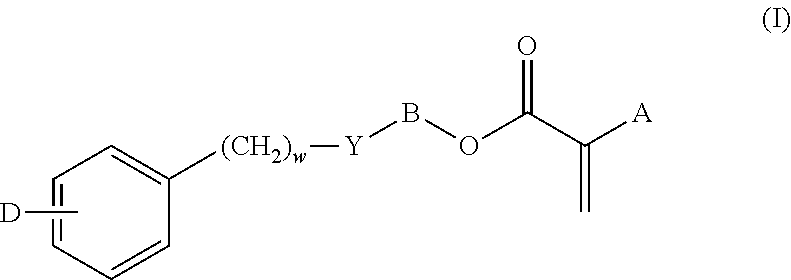High refractive index, acrylic ophthalmic device materials with reduced glistenings
a technology of acrylic ophthalmic and ophthalmic devices, applied in the field of soft, high refractive index acrylic device materials, can solve the problems of less desirable than other materials, prone to explosive unfolding, and relatively low refractive index of hydrogel materials, and achieve the effect of reducing or eliminating temperature-induced glitter formation in hydrophobic acrylic copolymers
- Summary
- Abstract
- Description
- Claims
- Application Information
AI Technical Summary
Benefits of technology
Problems solved by technology
Method used
Image
Examples
example 1
[0085]A representative IOL formulation is shown in Table 1. It may be prepared as follows. Components are taken from the refrigerator, freezer or cabinet and set on lab bench for about 2 hours. The components are weighed in the indicated ratios, dissolved, and vortex mixed in a 40 ml glass vial. The formulation is purged with nitrogen for 2 minutes, placed under high vacuum (<0.5 mm Hg) for 2 minutes, injected through a 0.2 micron PTFE filter into standard polypropylene slab molds or lens wafers, and then heated: room temp. to 70° C. (20 min. ramp), 70° C. (60 min. soak), 70-110° C. (20 min. ramp), 110° C. (120 min. soak).
[0086]
TABLE 1Component% (w / w)phenylethyl acrylate (PEA)73.6phenylethyl methacrylate (PEMA)20.11,4-butanediol diacrylate (BDDA)1.53-(3-tert-butyl-4-hydroxy-5-(5-methoxy-2H-benzo[d]-1.8[1,2,3]-triazol-2-yl)phenoxy)propyl methacrylate2-hydroxy-3-((4-methoxyphenyl)-diazenyl)-5-0.02methylbenzyl methacrylateIEMA functionalized PEG5000 monomethyl ether3.02,2′-Azobis(2-met...
example 2
Synthesis of 5,000 MW PEG-Methacrylate
[0087]In a 250 ml round bottom flask equipped with magnetic stirrer was dissolved 24 g (5.0 mmol) poly(ethylene glycol) monomethyl ether (Mn=5,000, Aldrich, Milwaukee, Wis.), 1.5 g (9.6 mmol) 2-isocyanatoethyl methacrylate (IEMA) (Aldrich), and 50 mg (0.1 mmol) stannous octoate in 100 ml THF (Aldrich, inhibited with MEHQ). The reaction mixture was heated to 60° C. for 20 hours. The reaction mixture was poured dropwise into diethyl ether to precipitate the polymer. The polymer was filtered using a fritted funnel with medium pore size. The polymer was redissolved in THF and precipitated a total of 3 times and then dried at ambient temperature and high vacuum (0.1 mm Hg) to give 21 g (86%) of a white solid with Mn=8,600, Mw=9,000, Mz=9,400, PDI=1.04 using polystyrene standards. Purity was estimated at greater than 98% by GPC.
[0088]
example 3
[0089]The high molecular weight, linear polyethylene glycol component of Example 2 was formulated as shown in Table 2. Test samples measuring 0.9 mm in thickness were thermally cured at 70° C. for 1 hour and 110° C. for 2 hours. Samples were extracted in acetone for 5 hours at 55° C. or 20 hours at ambient temperature and then dried slowly at ambient temperature for 20 hours, followed by vacuum (0.1 mm Hg) for a minimum of 20 hours at 70° C.
[0090]Weight percent extractables, equilibrium water content (EWC), and slab appearance of hydrated samples that were subjected to a 45-22° C. delta T test are shown in Table 3.
[0091]Linear polyethylene glycol diacrylate having a number average molecular weight of 4,000 Daltons was also formulated as shown in Table 4 and Table 6. A formulation comprised of 82.5% PEA, 2.00% polyethylene glycol dimethacrylate (average Mn=6,000 Da), 14.0% HEMA, and 1.52% TEGDMA appeared homogeneous, but could not be filtered through 0.2 or 1.0 mi...
PUM
| Property | Measurement | Unit |
|---|---|---|
| molecular weight | aaaaa | aaaaa |
| molecular weight | aaaaa | aaaaa |
| molecular weight | aaaaa | aaaaa |
Abstract
Description
Claims
Application Information
 Login to View More
Login to View More - R&D
- Intellectual Property
- Life Sciences
- Materials
- Tech Scout
- Unparalleled Data Quality
- Higher Quality Content
- 60% Fewer Hallucinations
Browse by: Latest US Patents, China's latest patents, Technical Efficacy Thesaurus, Application Domain, Technology Topic, Popular Technical Reports.
© 2025 PatSnap. All rights reserved.Legal|Privacy policy|Modern Slavery Act Transparency Statement|Sitemap|About US| Contact US: help@patsnap.com



